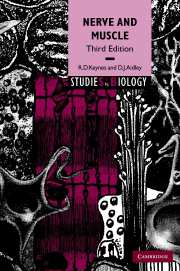Book contents
- Frontmatter
- Contents
- Preface
- Publishers note
- 1 Structural organization of the nervous system
- 2 Resting and action potentials
- 3 The ionic permeability of the nerve membrane
- 4 Membrane permeability changes during excitation
- 5 Voltage-gated ion channels
- 6 Cable theory and saltatory conduction
- 7 Neuromuscular transmission
- 8 Synaptic transmission in the nervous system
- 9 Skeletal muscles
- 10 The mechanism of contraction in skeletal muscle
- 11 Non-skeletal muscles
- Further reading
- References
- Index
9 - Skeletal muscles
Published online by Cambridge University Press: 05 June 2012
- Frontmatter
- Contents
- Preface
- Publishers note
- 1 Structural organization of the nervous system
- 2 Resting and action potentials
- 3 The ionic permeability of the nerve membrane
- 4 Membrane permeability changes during excitation
- 5 Voltage-gated ion channels
- 6 Cable theory and saltatory conduction
- 7 Neuromuscular transmission
- 8 Synaptic transmission in the nervous system
- 9 Skeletal muscles
- 10 The mechanism of contraction in skeletal muscle
- 11 Non-skeletal muscles
- Further reading
- References
- Index
Summary
Skeletal muscles are the engines of the body. They account for over a quarter of its weight and the major part of its energy expenditure. They are attached to the bones of the skeleton and so serve to produce movements or exert forces. Hence they are used in such activities as locomotion, maintenance of posture, breathing, eating, directing the gaze and producing gestures and facial expressions.
Skeletal muscles are activated by motoneurons as we have seen in previous chapters. Their cells are elongate and multinuclear and the contractile material within them shows cross-striations, hence skeletal muscle is a form of striated muscle. In contrast, cardiac and smooth muscles have cells with single nuclei, and smooth muscles are not striated; we shall examine their properties in a later chapter.
Anatomy
Skeletal muscle fibres are multinucleate cells (Fig. 9.1) formed by the fusion of numbers of elongated uninucleate cells called myoblasts. Mature fibres may be as long as the muscle of which they form part, and 10 to 100 μm in diameter. The nuclei are arranged around the edge of the fibre. Most of the interior of the fibre consists of the protein filaments which constitute the contractile apparatus, grouped together in bundles called myofibrils. The myofibrils are surrounded by cytoplasm (or sarcoplasm), which also contains mitochondria, the internal membrane systems of the sarcoplasmic reticulum and the T system, and a fuel store in the form of glycogen granules and sometimes a few fat droplets.
- Type
- Chapter
- Information
- Nerve and Muscle , pp. 118 - 135Publisher: Cambridge University PressPrint publication year: 2001



